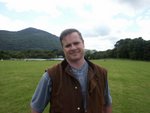After a week of power failures and Internet problems, I'm finally posting some Scotland pictures. It was really hard to choose just a few. I took over 1,300 pictures this time. This set is all in Edinburgh. Edinburgh is a great city to visit. Almost everything you'd want to see, you can see without ever getting in a car. When we are in Edinburgh, we walk everywhere. About the only exception would be if we take a trip to see the Royal Yacht Britannia in Leith Harbor.

Edinburgh Castle sits on an extinct volcano.
The earliest historical accounts of a fortress here date to the 600's C.E.,
but the site was likely occupied at least since 1500 B.C.E.

Houses like these that sit at the edge of the Esplanade
outside Edinburgh Castle and dating to the 1500's,
once lined both sides of the "Royal Mile" in the old town.

The One O'Clock Gun.
Needing a way for the ships in the harbor in Leith to set their clocks,
the merchants in Edinburgh decided upon using a gun fired
from the Castle at 1PM each day.
Standing on the docks in Leith when you hear the gun,
it is six seconds past 1PM.

St. Margaret's Chapel.
Built in 1124 by David I in honor of his mother St. Margaret,
the chapel is the oldest existing structure in Edinburgh Castle.
One of the best preserved early Norman buildings anywhere in Britain.
The gun in the left foreground is known as Mons Meg.

Mons Meg.
One of the largest bore cannon ever built (bore is twenty inches),
it was a gift from Philip III, Duke of Burgundy to James II in 1457.
Mons Meg could hurl a 150kg projectile 2.5 miles.
It was last fired in a celebration in 1680, when the barrel exploded.

The Scottish War Memorial.
Also within the Castle, this memorial is dedicated to the 150,000 Scots,
out of 4.8 million, who were killed in WWI.
At just over 3% of the total national population,
Scotland had the highest casualty rate of any nation during WWI.

Edinburgh Castle at night as seen from Prince's Street.

Edinburgh Castle as seen from Arthur's Seat,
another extinct volcano on the other end of town.

Arthur's Seat. Extinct volcano on south end of town.
We climbed this on what became a very windy, cold and rainy day.
The sun came back out after we reached the bottom.

The Scottish Parliament.
I rarely hear a kind word about the choice of design.
Most consider it a monstrosity thrust in the midst of historic buildings.
Calton Hill and Nelson's Monument is in the background.
Calton Hill is another extinct volcano.

Another view as we ascended Arthur's Seat.
The white building the foreground is Dynamic Earth.
Dynamic Earth is a learning center teaching Earth's
geological evolution through the use of dynamic interactive displays.
To the right of the picture is Holyrood Palace.
This is the Queen's residence when she's in Edinburgh.
The water in the background is the estuary known as the Firth of Forth.
The harbor of Leith is located there.

The two oldest houses in Edinburgh.
The white house was home to John Knox, Protestant reformer.
The house immediately to the left is the oldest house in Edinburgh,
built around 1470.
John Knox' house was built around 1490.

The Heart of Midlothian.
It gets its name from the book by Sir Walter Scott.
Only visitor's who don't know the history step in it.
Residents spit in it as they pass. It's bad luck to step in it.
This was the location of the cell wherein prisoners awaited execution.

St. Giles Cathedral at night.
This was John Knox' parish church.
The church graveyard was paved over and
headstones removed in the 1800's.
John Knox is buried under parking slot 24
on the other side of the building.

Day or night, Edinburgh provides some great spooky shots.

House at the end of the Dean Bridge.
Dean Bridge was built in 1832 by Thomas Telford, linking
Queensferry Road and Queensferry Street over the Water of Leith.
The house is located to the northwest corner of the city center.





